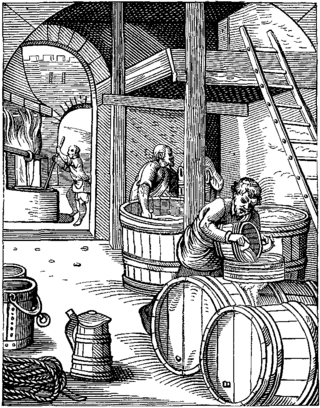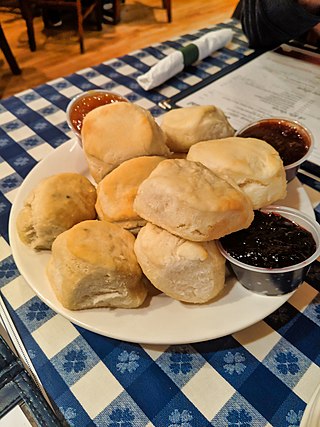Related Research Articles

Brewing is the production of beer by steeping a starch source in water and fermenting the resulting sweet liquid with yeast. It may be done in a brewery by a commercial brewer, at home by a homebrewer, or communally. Brewing has taken place since around the 6th millennium BC, and archaeological evidence suggests that emerging civilizations, including ancient Egypt and Mesopotamia, brewed beer. Since the nineteenth century the brewing industry has been part of most western economies.

Yeast extracts consist of the cell contents of yeast without the cell walls; they are used as food additives or flavorings, or as nutrients for bacterial culture media. They are often used to create savory flavors and umami taste sensations, and can be found in a large variety of packaged food, including frozen meals, crackers, snack foods, gravy, stock and more. They are rich in B vitamins. Yeast extracts and fermented foods contain glutamic acid, an amino acid which adds an umami flavor. Glutamic acid is found in meat, cheese, fungi, and vegetables—such as broccoli, and tomatoes.

Yeasts are eukaryotic, single-celled microorganisms classified as members of the fungus kingdom. The first yeast originated hundreds of millions of years ago, and at least 1,500 species are currently recognized. They are estimated to constitute 1% of all described fungal species.

Ascomycota is a phylum of the kingdom Fungi that, together with the Basidiomycota, forms the subkingdom Dikarya. Its members are commonly known as the sac fungi or ascomycetes. It is the largest phylum of Fungi, with over 64,000 species. The defining feature of this fungal group is the "ascus", a microscopic sexual structure in which nonmotile spores, called ascospores, are formed. However, some species of the Ascomycota are asexual, meaning that they do not have a sexual cycle and thus do not form asci or ascospores. Familiar examples of sac fungi include morels, truffles, brewers' and bakers' yeast, dead man's fingers, and cup fungi. The fungal symbionts in the majority of lichens such as Cladonia belong to the Ascomycota.

Cake is a flour confection made from flour, sugar, and other ingredients, and is usually baked. In their oldest forms, cakes were modifications of bread, but cakes now cover a wide range of preparations that can be simple or elaborate, and which share features with desserts such as pastries, meringues, custards, and pies.

Mother of vinegar is a biofilm composed of a form of cellulose, yeast, and bacteria that sometimes develops on fermenting alcoholic liquids during the process that turns alcohol into acetic acid with the help of oxygen from the air and acetic acid bacteria (AAB). It is similar to the symbiotic culture of bacteria and yeast (SCOBY) mostly known from production of kombucha, but develops to a much lesser extent due to lesser availability of yeast, which is often no longer present in wine/cider at this stage, and a different population of bacteria. Mother of vinegar is often added to wine, cider, or other alcoholic liquids to produce vinegar at home, although only the bacteria is required, but historically has also been used in large scale production.

A croissant is a buttery, flaky, viennoiserie pastry inspired by the shape of the Austrian kipferl but using the French yeast-leavened laminated dough. Croissants are named for their historical crescent shape, the dough is layered with butter, rolled and folded several times in succession, then rolled into a thin sheet, in a technique called laminating. The process results in a layered, flaky texture, similar to a puff pastry.

Poi is a traditional staple food in the Polynesian diet, made from taro.

Dough is a thick, malleable, sometimes elastic paste made from grains or from leguminous or chestnut crops. Dough is typically made by mixing flour with a small amount of water or other liquid and sometimes includes yeast or other leavening agents, as well as ingredients such as fats or flavorings.

Nutritional yeast is a deactivated yeast, often a strain of Saccharomyces cerevisiae, that is sold commercially as a food product. It is sold in the form of yellow flakes, granules, or powder and can be found in the bulk aisle of most natural food stores. It is popular with vegans and vegetarians and may be used as an ingredient in recipes or as a condiment.

Beer head is the frothy foam on top of beer and carbonated beverages which is produced by bubbles of gas, predominantly carbon dioxide, rising to the surface. The elements that produce the head are wort protein, yeast and hop residue. The carbon dioxide that forms the bubbles in the head is produced during fermentation as yeasts break down sugar-rich molecules to produce ethanol and carbon dioxide. The carbonation can occur before or after bottling the beer. If the beer continues fermenting in the bottle, then it naturally carbonates and the head is formed upon opening and/or pouring the beer. If the beer is pasteurized or filtered then the beer must be force carbonated using pressurized gas.

A loaf is a (usually) rounded or oblong mass of food, typically and originally of bread. It is common to bake bread in a rectangular bread pan or loaf pan because some kinds of bread dough tend to collapse and spread out during the cooking process if not constrained; the shape of less viscous doughs can be maintained with a bread pan whose sides are higher than the uncooked dough. More viscous doughs can be hand-molded into the desired loaf shape and cooked on a flat oven tray.

Saccharomycotina is a subdivision (subphylum) of the division (phylum) Ascomycota in the kingdom Fungi. It comprises most of the ascomycete yeasts. The members of Saccharomycotina reproduce by budding and they do not produce ascocarps.
The Chorleywood bread process (CBP) is a method of efficient dough production to make yeasted bread quickly, producing a soft, fluffy loaf. Compared to traditional bread-making processes, CBP uses more yeast, added fats, chemicals, and high-speed mixing to allow the dough to be made with lower-protein wheat, and produces bread in a shorter time. It was developed by Bill Collins, George Elton and Norman Chamberlain of the British Baking Industries Research Association at Chorleywood in 1961. As of 2009, 80% of bread made in the United Kingdom used the process.

A sheet cake or slab cake is a cake baked in a large, flat, rectangular cake pan. Sheet cakes can be grouped into two broad categories.

Cider is an alcoholic beverage made from the fermented juice of apples. Cider is widely available in the United Kingdom and the Republic of Ireland. The UK has the world's highest per capita consumption, as well as the largest cider-producing companies. Ciders from the South West of England are generally higher in alcoholic content. Cider is also popular in many Commonwealth countries, such as India, Canada, Australia, and New Zealand. As well as the UK and its former colonies, cider is popular in Portugal, France, Friuli, and northern Spain. Germany also has its own types of cider with Rhineland-Palatinate and Hesse producing a particularly tart version known as Apfelwein. In the U.S., varieties of fermented cider are often called hard cider to distinguish alcoholic cider from non-alcoholic apple cider or "sweet cider", also made from apples. In Canada, cider cannot contain less than 2.5% or over 13% absolute alcohol by volume.

In the United States and Canada, a biscuit is a variety of baked bread with a firm, dry exterior and a soft, crumbly interior. It is made with baking powder as a leavening agent rather than yeast, and at times is called a baking powder biscuit to differentiate it from other types. Like other forms of bread, a biscuit is often served with butter or other condiments, flavored with other ingredients, or combined with other types of food to make sandwiches or other dishes.

A spit cake is a European-styled cake made with layers of dough or batter deposited, one at a time, onto a tapered cylindrical rotating spit. The dough is baked by an open fire or a special oven, rotisserie-style. Generally, spit cakes are associated with celebrations such as weddings and Christmas. The spit can be dipped in a thin dough, or the dough can be poured or rolled on the spit.

The chemical compounds in beer give it a distinctive taste, smell and appearance. The majority of compounds in beer come from the metabolic activities of plants and yeast and so are covered by the fields of biochemistry and organic chemistry. The main exception is that beer contains over 90% water and the mineral ions in the water (hardness) can have a significant effect upon the taste.

A babka is a sweet braided bread which originated in the Jewish communities of Poland and Ukraine. It is popular in Israel and in the Jewish diaspora. It is prepared with a yeast-leavened dough that is rolled out and spread with a filling such as chocolate, cinnamon, fruit, or cheese, then rolled up and braided before baking.